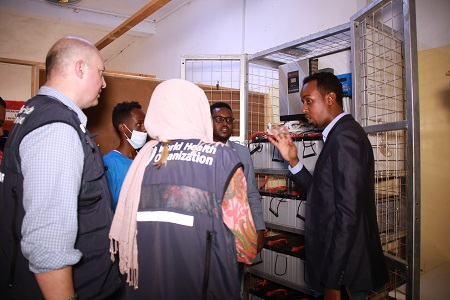 The high-level mission views the solar-powered medical oxygen plant in Dhushamareb, Somalia in June 2022. Photo credit: WHO Somalia.
The high-level mission views the solar-powered medical oxygen plant in Dhushamareb, Somalia in June 2022. Photo credit: WHO Somalia.
Mogadishu, 26 June 2022– From 13 to 17 June 2022, the Federal Ministry of Health and Human Services and the World Health Organization (WHO) country office for Somalia hosted a technical mission from WHO headquarters and Regional Office for the Eastern Mediterranean, comprising experts from the new Innovation Hub team, as well as the Environment, Climate Change, and Health team. The mission aimed to bring together key partners, including United Nations agencies, nongovernmental organizations and donors, to explore and advocate for ways to reinforce the Somali health system using climate-friendly solutions, such as the use of solar power for delivering oxygen and electrifying health facilities, especially in remote and hard-to-reach locations.
The global climate crisis, identified as the single largest health crisis facing humanity today, has resulted in an extreme phenomenon of droughts and floods occurring on an annual basis in Somalia. Meanwhile, the ongoing drought has left Somalia on the brink of famine, with a sobering 6.1 million people food insecure and 1.7 million people suffering from extreme levels of hunger.
Coupled with high rates of indoor air pollution, caused by the use of fossil fuels in households, and air temperatures which are estimated to be rising every year, these conditions are brewing an inescapable health storm in an already fragile country.
WHO has installed 3 solar-powered medical oxygen systems in Dhushamareb, Baidoa and Kismayo. The first plant, set up early in 2021 in Dhushamareb, paved the way for replication and possible expansion, as there was a survival rate of 96% in children who were admitted in this hospital with birth asphyxia, pneumonia and other medical conditions that required immediate oxygen therapy. These children may have otherwise lost their lives without access to high-grade medical oxygen provided by this innovative system.
“During our innovative journey to improve medical oxygen access, we discovered that the necessity for a reliable source of electricity can be met using solar power. Innovation can make this feasible and sustainable in Somalia. Therefore, we are now considering the possibility of using solar power to provide enough electricity to power entire health facilities – from medical oxygen and refrigerators for vaccines, to incubators, lighting and operating theatres,” said HE Dr Fawziya Abikar Nur, the Minister of Health and Human Services, the Federal Government of Somalia.
After a visit to the solar-powered oxygen plant in the Hanano Hospital in Dhushamareb, the Director a.i., Department for Digital Health and Innovation and Unit Head, at the WHO Innovation Hub, Louise Agersnap, urged partners to reflect on the situation in Somalia. “What makes a pregnant woman travel for hundreds of miles to deliver a baby that she can hold? It is that “lighthouse” of a hospital that has reliable, solar-powered electricity that can secure a safe birth,” she said. “Innovation is a tool to solve problems, and in this case, we solved many in one shot. Somalia is leading the way, and we at the WHO Innovation Hub are proud to collaborate with the Government and WHO country team. Their innovative use of solar power is bringing multiple wins to the country – it is saving lives; saving health care costs; and saving the environment as it uses green, renewable energy.”
“Delaying action would be denying action,” said Salvatore Vinci, WHO Sustainable Energy Advisor. “We must act now to support more health facilities to access power through solar energy. Somalia makes the best case for investment in solar energy in health centres ─ with hours of sunshine, limited and expensive electricity, as well as hospitals without reliable power."
While explaining how the electrification of facilities could be useful, WHO’s Technical Lead and Unit Head of Air Quality, Energy and Health, Heather Adair-Rohani, said, “Electrifying health care facilities with solar energy can ensure access to quality essential services for women and children, promote the uptake of health care services, cut health care costs, all the while protecting our climate.”
Dr Mamunur Rahman Malik, WHO Representative to Somalia and Head of Mission emphasized, "There is no alternative for oxygen. Pneumonia is one of the most common causes of child deaths in Somalia. Every child and every human have the right to breathe clean air, drink clean water and access good-quality health services. It is incumbent on us all to ensure every Somali has access to these basic human rights, using innovative and climate-friendly solutions.”
For additional information, kindly contact:
Khadar Hussein Mohamud, Head of Coordination and Communications, Ministry of Health, Federal Government of Somalia, This email address is being protected from spambots. You need JavaScript enabled to view it.
Abdirahman Ahmed Ali, Communication Officer, Ministry of Health, Federal Government of Somalia, This email address is being protected from spambots. You need JavaScript enabled to view it.
Fouzia Bano, WHO Somalia Chief of Staff ai, Communications Officer, This email address is being protected from spambots. You need JavaScript enabled to view it.
Kyle DeFreitas, WHO Somalia External Relations Lead, This email address is being protected from spambots. You need JavaScript enabled to view it.
Note to editors
The Global Action Plan for SDG3 (SDG3-GAP), comprising 13 agencies, Grand Challenges Canada, and an innovator, Dr Michael Hawkes, provided support to the first solar-powered oxygen plant in Dhushamareb.
Please visit the following links for additional information:
Counting every breath: leveraging the COVID-19 response to increase access to medical oxygen in Somalia
WHO EMRO | WHO and EU hand over life-saving medical oxygen plant to Somalia: a landmark achievement in bridging gaps in oxygen supply in the country | News | Somalia site
Solar-powered medical oxygen systems saving lives in Somalia: using innovation to accelerate impact in a fragile setting
How a gloomy night brought a bright light in the fight against COVID-19
Counting every breath: a data-driven strategy to improve access to medical oxygen for COVID-19 patients in Somalia
Every breath counts: utilizing the COVID-19 response to increase access to oxygen
Survival analysis of critically ill patients with COVID-19 admitted to hospital in Somalia: how important was oxygen?
Solar-powered oxygen delivery in Somalia: the vital need beyond COVID-19
Historical moment for Somalia as COVID-19 vaccines arrive through COVAX Facility
WHO EMRO | Quarterly technical programme updates | Information resources | Somalia site
 The high-level mission views the solar-powered medical oxygen plant in Dhushamareb, Somalia in June 2022. Photo credit: WHO Somalia.
The high-level mission views the solar-powered medical oxygen plant in Dhushamareb, Somalia in June 2022. Photo credit: WHO Somalia.
Mogadishu, 26 June 2022– From 13 to 17 June 2022, the Federal Ministry of Health and Human Services and the World Health Organization (WHO) country office for Somalia hosted a technical mission from WHO headquarters and Regional Office for the Eastern Mediterranean, comprising experts from the new Innovation Hub team, as well as the Environment, Climate Change, and Health team. The mission aimed to bring together key partners, including United Nations agencies, nongovernmental organizations and donors, to explore and advocate for ways to reinforce the Somali health system using climate-friendly solutions, such as the use of solar power for delivering oxygen and electrifying health facilities, especially in remote and hard-to-reach locations.
The global climate crisis, identified as the single largest health crisis facing humanity today, has resulted in an extreme phenomenon of droughts and floods occurring on an annual basis in Somalia. Meanwhile, the ongoing drought has left Somalia on the brink of famine, with a sobering 6.1 million people food insecure and 1.7 million people suffering from extreme levels of hunger.
Coupled with high rates of indoor air pollution, caused by the use of fossil fuels in households, and air temperatures which are estimated to be rising every year, these conditions are brewing an inescapable health storm in an already fragile country.
WHO has installed 3 solar-powered medical oxygen systems in Dhushamareb, Baidoa and Kismayo. The first plant, set up early in 2021 in Dhushamareb, paved the way for replication and possible expansion, as there was a survival rate of 96% in children who were admitted in this hospital with birth asphyxia, pneumonia and other medical conditions that required immediate oxygen therapy. These children may have otherwise lost their lives without access to high-grade medical oxygen provided by this innovative system.
“During our innovative journey to improve medical oxygen access, we discovered that the necessity for a reliable source of electricity can be met using solar power. Innovation can make this feasible and sustainable in Somalia. Therefore, we are now considering the possibility of using solar power to provide enough electricity to power entire health facilities – from medical oxygen and refrigerators for vaccines, to incubators, lighting and operating theatres,” said HE Dr Fawziya Abikar Nur, the Minister of Health and Human Services, the Federal Government of Somalia.
After a visit to the solar-powered oxygen plant in the Hanano Hospital in Dhushamareb, the Director a.i., Department for Digital Health and Innovation and Unit Head, at the WHO Innovation Hub, Louise Agersnap, urged partners to reflect on the situation in Somalia. “What makes a pregnant woman travel for hundreds of miles to deliver a baby that she can hold? It is that “lighthouse” of a hospital that has reliable, solar-powered electricity that can secure a safe birth,” she said. “Innovation is a tool to solve problems, and in this case, we solved many in one shot. Somalia is leading the way, and we at the WHO Innovation Hub are proud to collaborate with the Government and WHO country team. Their innovative use of solar power is bringing multiple wins to the country – it is saving lives; saving health care costs; and saving the environment as it uses green, renewable energy.”
“Delaying action would be denying action,” said Salvatore Vinci, WHO Sustainable Energy Advisor. “We must act now to support more health facilities to access power through solar energy. Somalia makes the best case for investment in solar energy in health centres ─ with hours of sunshine, limited and expensive electricity, as well as hospitals without reliable power."
While explaining how the electrification of facilities could be useful, WHO’s Technical Lead and Unit Head of Air Quality, Energy and Health, Heather Adair-Rohani, said, “Electrifying health care facilities with solar energy can ensure access to quality essential services for women and children, promote the uptake of health care services, cut health care costs, all the while protecting our climate.”
Dr Mamunur Rahman Malik, WHO Representative to Somalia and Head of Mission emphasized, "There is no alternative for oxygen. Pneumonia is one of the most common causes of child deaths in Somalia. Every child and every human have the right to breathe clean air, drink clean water and access good-quality health services. It is incumbent on us all to ensure every Somali has access to these basic human rights, using innovative and climate-friendly solutions.”
For additional information, kindly contact:
Khadar Hussein Mohamud, Head of Coordination and Communications, Ministry of Health, Federal Government of Somalia, This email address is being protected from spambots. You need JavaScript enabled to view it.
Abdirahman Ahmed Ali, Communication Officer, Ministry of Health, Federal Government of Somalia, This email address is being protected from spambots. You need JavaScript enabled to view it.
Fouzia Bano, WHO Somalia Chief of Staff ai, Communications Officer, This email address is being protected from spambots. You need JavaScript enabled to view it.
Kyle DeFreitas, WHO Somalia External Relations Lead, This email address is being protected from spambots. You need JavaScript enabled to view it.
Note to editors
The Global Action Plan for SDG3 (SDG3-GAP), comprising 13 agencies, Grand Challenges Canada, and an innovator, Dr Michael Hawkes, provided support to the first solar-powered oxygen plant in Dhushamareb.
Please visit the following links for additional information:
Counting every breath: leveraging the COVID-19 response to increase access to medical oxygen in Somalia
WHO EMRO | WHO and EU hand over life-saving medical oxygen plant to Somalia: a landmark achievement in bridging gaps in oxygen supply in the country | News | Somalia site
Solar-powered medical oxygen systems saving lives in Somalia: using innovation to accelerate impact in a fragile setting
How a gloomy night brought a bright light in the fight against COVID-19
Counting every breath: a data-driven strategy to improve access to medical oxygen for COVID-19 patients in Somalia
Every breath counts: utilizing the COVID-19 response to increase access to oxygen
Survival analysis of critically ill patients with COVID-19 admitted to hospital in Somalia: how important was oxygen?
Solar-powered oxygen delivery in Somalia: the vital need beyond COVID-19
Historical moment for Somalia as COVID-19 vaccines arrive through COVAX Facility
WHO EMRO | Quarterly technical programme updates | Information resources | Somalia site
 The high-level mission views the solar-powered medical oxygen plant in Dhushamareb, Somalia in June 2022. Photo credit: WHO Somalia.
The high-level mission views the solar-powered medical oxygen plant in Dhushamareb, Somalia in June 2022. Photo credit: WHO Somalia.








